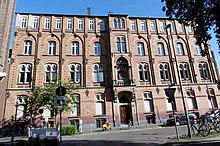Dominican monastery Aachen
The Dominican Monastery in Aachen was the branch of the Dominican Order in Jakobstraße in Aachen , which also includes the St. Paul Monastery Church , built at the beginning of the 15th century . The monastery was first mentioned in 1293 and secularized in 1802 during the period of French occupation . The convent building was then set up as a community hospital before the Order of the Sisters of the Poor Child Jesus took over the building complex in 1848 , whereas the monastery church continued to be used as a parish church from 1804 and, after being profaned in 2009, houses the diocesan archive of the diocese of Aachen . Both buildings were placed under monument protection by the lower monument authority in the 1980s .
history
Important representatives of the Dominicans, such as Thomas von Cantimpré or Albertus Magnus, had already traveled to Aachen several times in the early 13th century, where they had a so-called Termini , i.e. a place to stay for preachers and begging travelers. Albertus Magnus, as Provincial of the German-speaking Dominican Order Province of Teutonia , also inaugurated the Servatius Chapel in the sick department of the Burtscheid Abbey in 1267 . Furthermore, a deed of sale from November 15, 1293 shows that the commissioned members of the order Konrad von Clermont and Gerhard von Hutta were able to acquire the house of the wealthy Aachen citizen Rutger von Rodenburg and his wife Ida on Jakobstrasse, on whose property they then immediately start building one Dominican monastery began. At the same time a first oratory was set up there and consecrated to the Apostle Paul of Tarsus .
In the following period, the influence of the Dominicans in Aachen grew and they were generously given donations, foundations, inheritances and other contributions as well as the transfer of land and agricultural land outside the city walls by citizens and politicians, including land in the county of Hoorn and the knight's fief Driescher Hof in Aachen-Forst . As a result, at the end of the 14th century, for example, they were able to acquire additional areas for their monastery property and to build a new, fully-fledged monastery church.
These donation transfers led to tension between the city and the Dominicans, and in 1346 the city brought a complaint against the wealth of the order, which was harmful to the citizens. Regardless of this, the importance of the monastery continued to increase and the order was also given the authority to teach philosophy until it was transferred to the Jesuit community of Aachen in 1686 . The most famous philosophy students at that time were Matthias von Sittard , who subsequently worked as a preacher in Aachen until the 1560s, and Nikolaus Heyendal .
A large part of the monastery was destroyed in the great fire of Aachen in 1656. Many written archives were destroyed by the fire, only a few documents and a copy book from 1606, which proves the willingness to donate to the monastery, could be saved. However, since the funds were insufficient for the construction despite the financial reserves and material goods, the majority of the order members felt compelled to wander through the areas of Rhineland and Westphalia as well as southern Germany and Austria to the court of Emperor Ferdinand III in accordance with their statutes as mendicant orders . to hike to raise funds to build their monastery. This campaign was just as successful as the local donations and the monastery could be rebuilt more elaborately than before and its work resumed.
After the French invasion, the monastery was secularized in 1802 and transferred to the city of Aachen on September 10, 1804, which set up a community hospital for the commission for the poor. The monastery church of St. Paul was also recognized as a parish church and was initially affiliated with the main parish of St. Foillan before becoming the main parish, 2nd class, in 1826. In 1848 the Order of the Sisters of the Poor Child Jesus, founded by Clara Fey four years earlier, took over the former convent building and established their generalate there. The knight's fiefdom Driescher Hof took over the family of the cloth manufacturer Johann Arnold Bischoff , who made it available in 1858 as a charitable foundation of the poor administration of the city of Aachen.
literature
- Christian Quix : The former Dominican monastery and the parish of St. Paul in Aachen . M. Urlichs publishing house, Aachen 1833
- Elias H.Füllenbach: Aachen - Dominicans. In: Nordrheinisches Klosterbuch. Lexicon of the monasteries and monasteries until 1815, part 1: Aachen to Düren . Edited by Manfred Groten, Gisela Muschiol et al. Siegburg 2009 (Studies on Cologne Church History, Vol. 37.1), pp. 45–51.
Web links
Coordinates: 50 ° 46 ′ 28.6 " N , 6 ° 4 ′ 49.3" E

